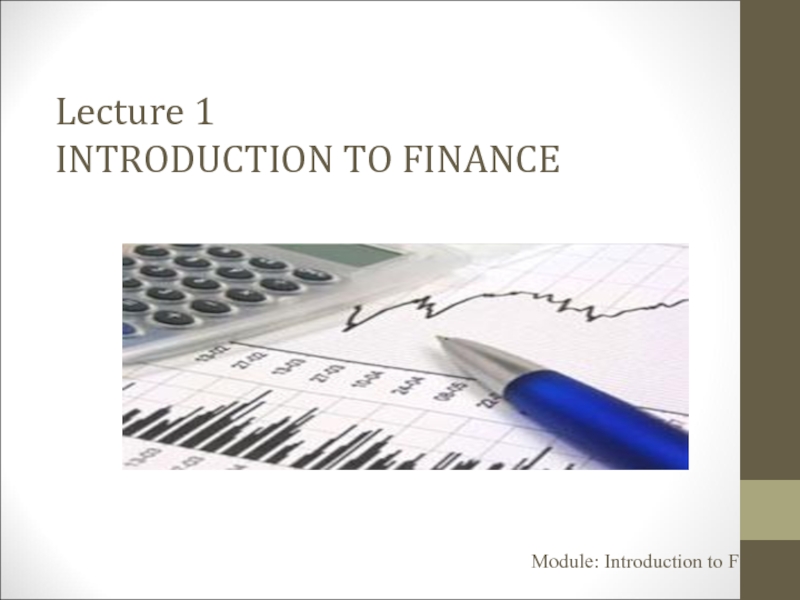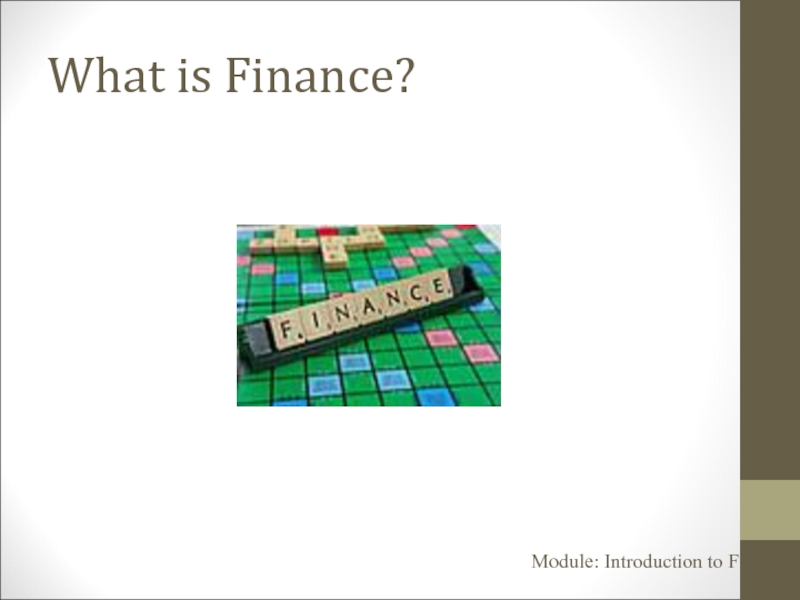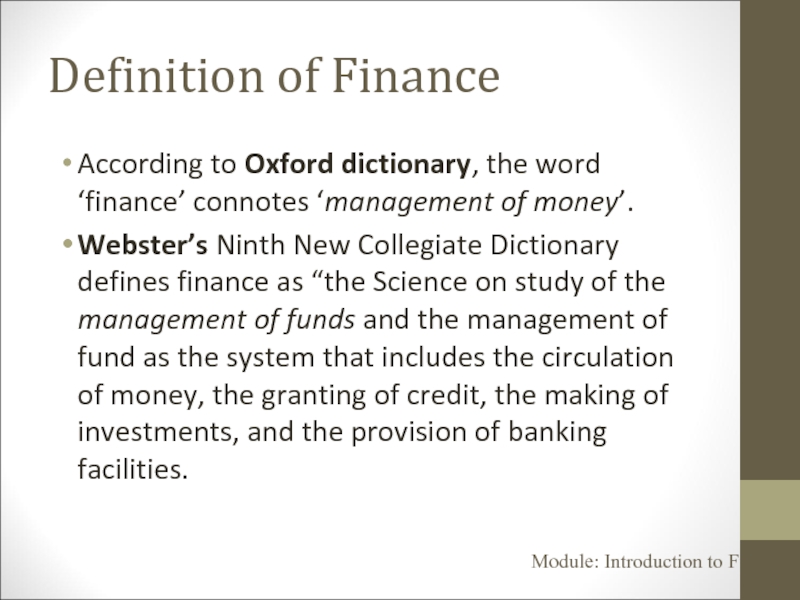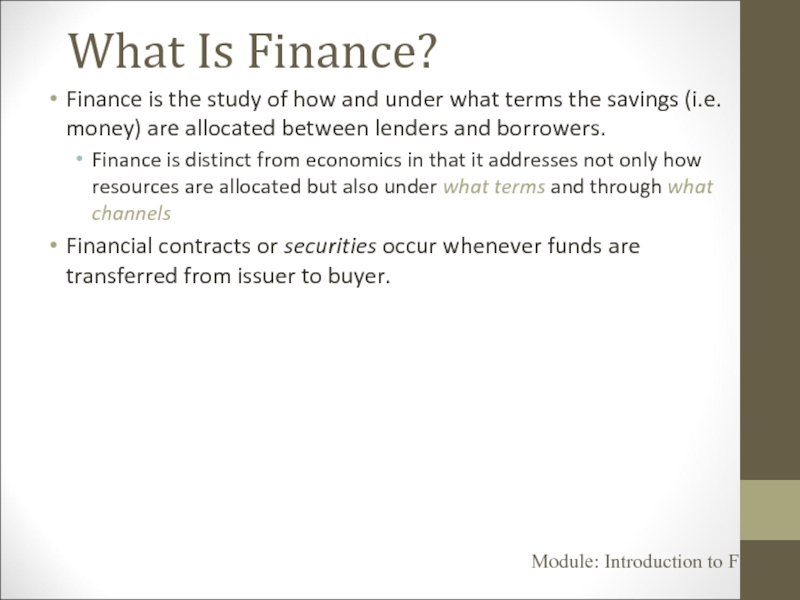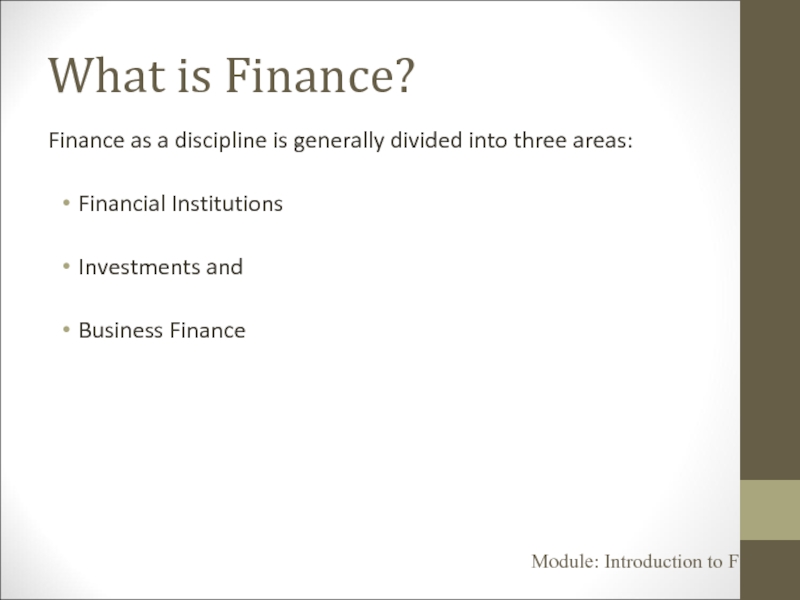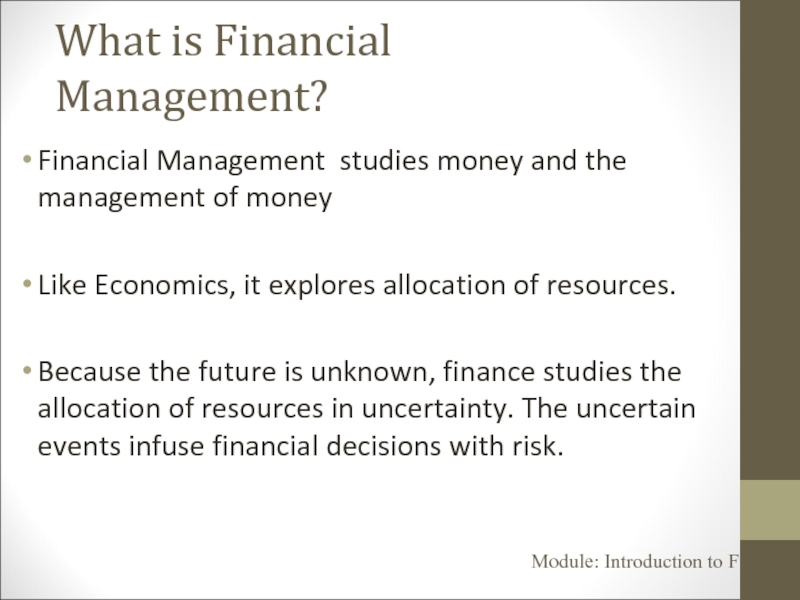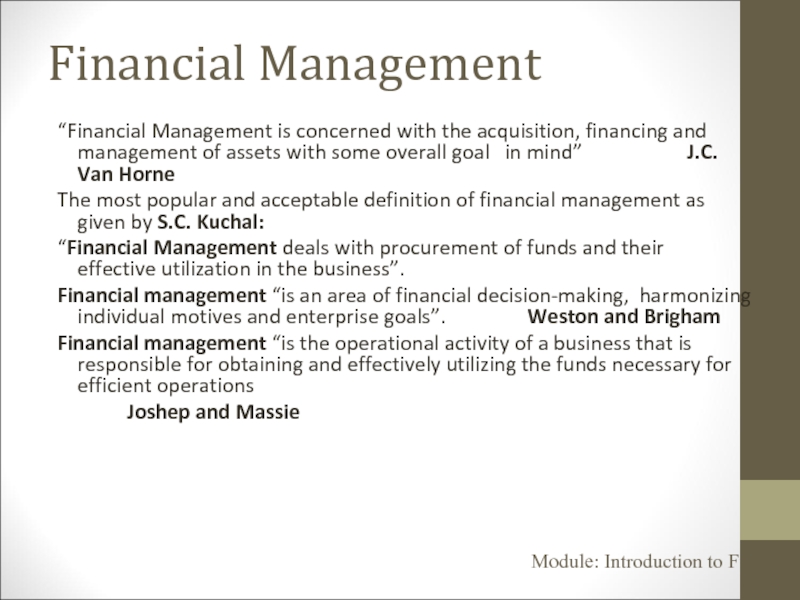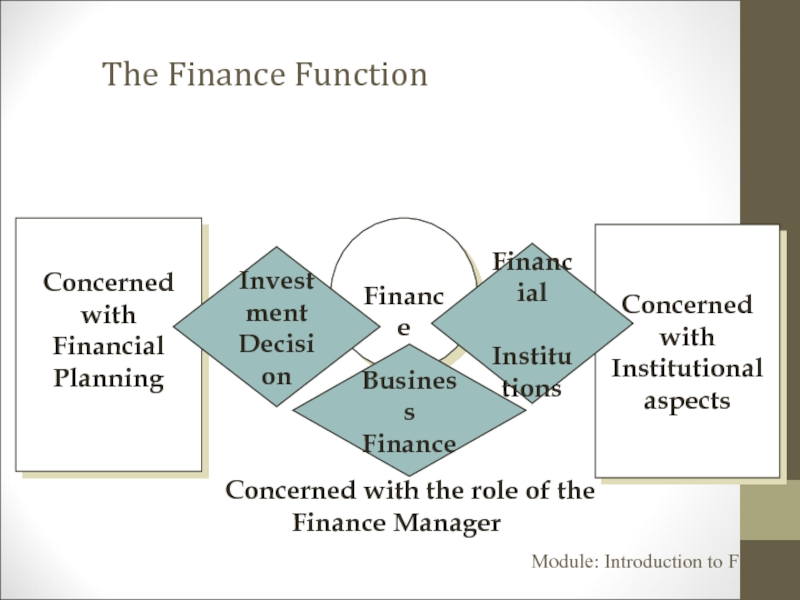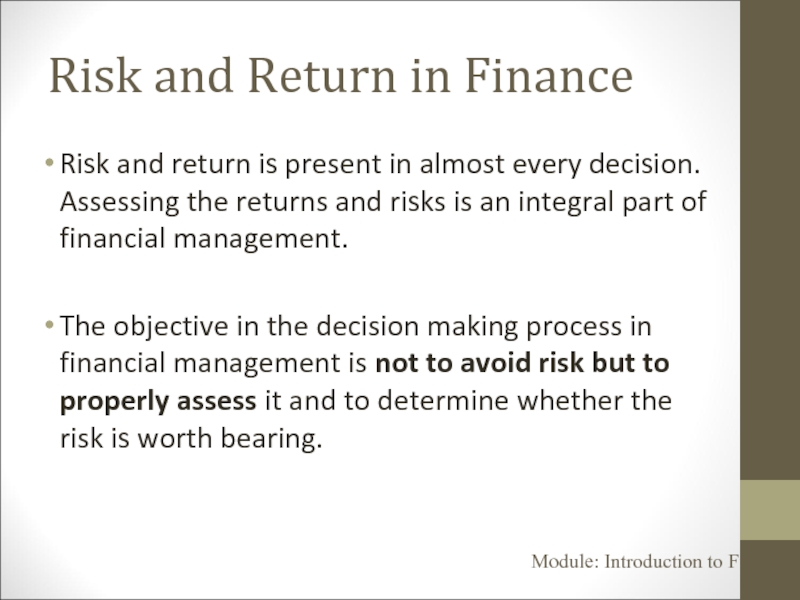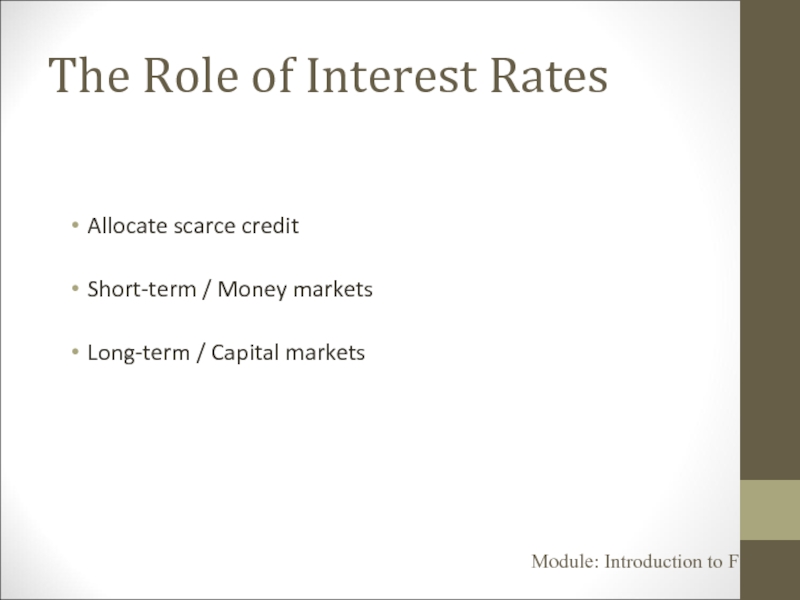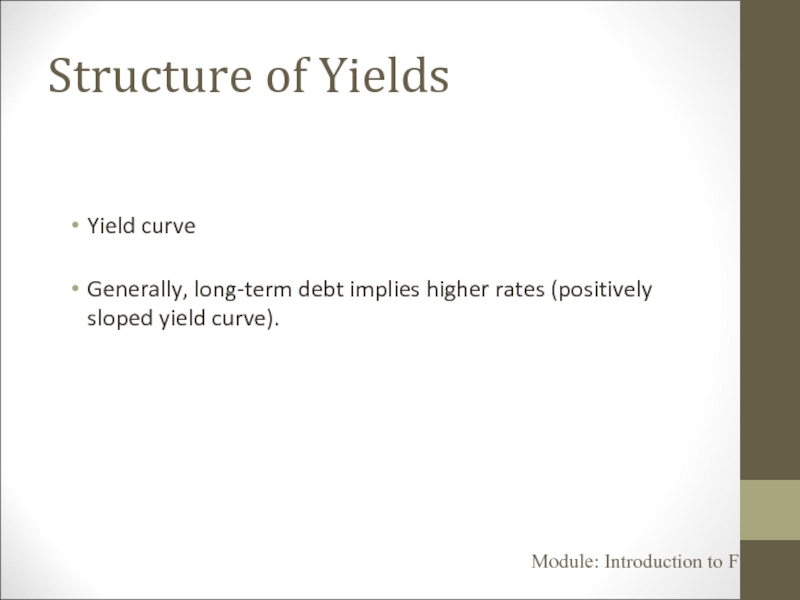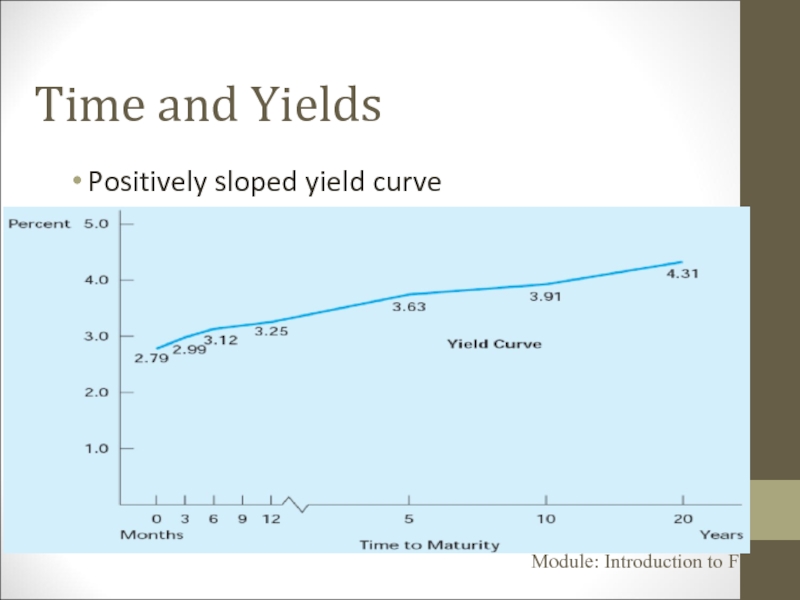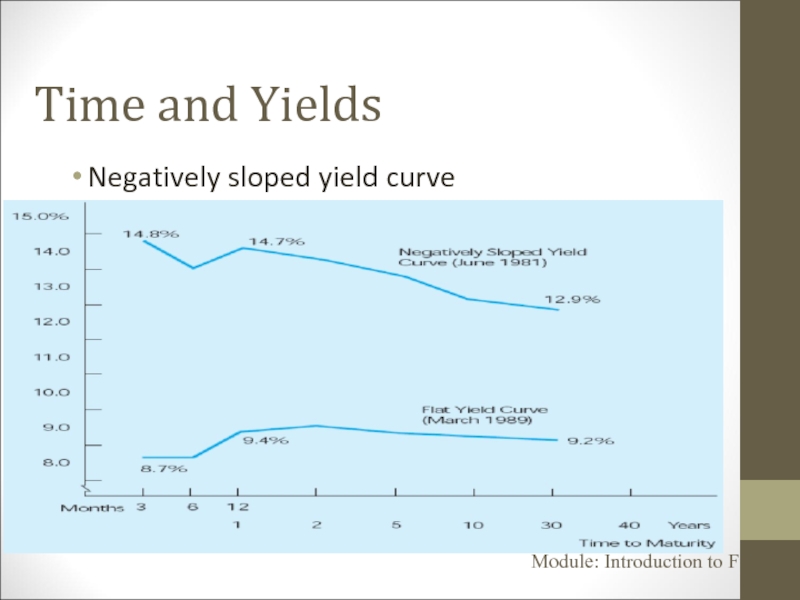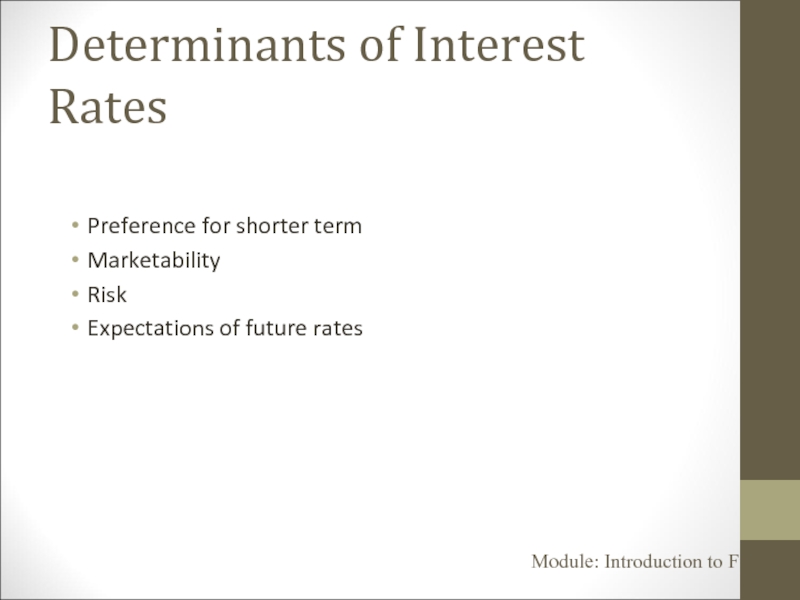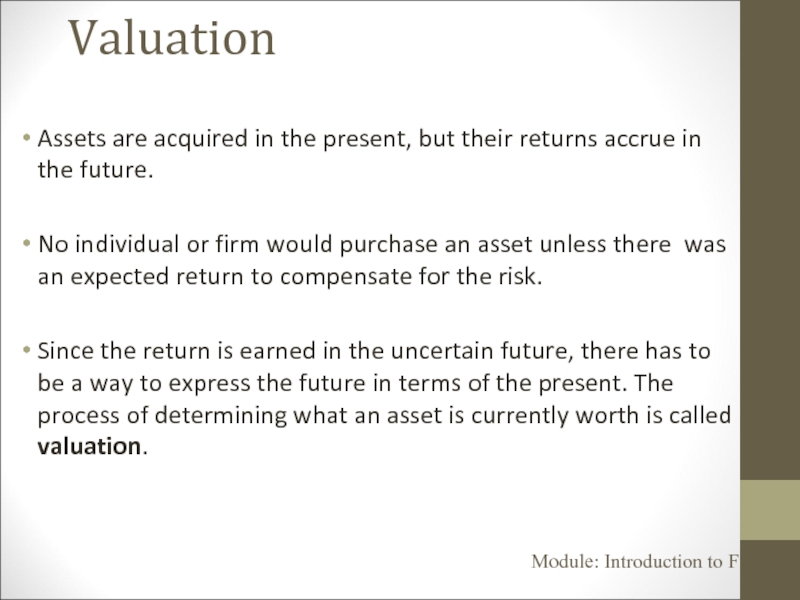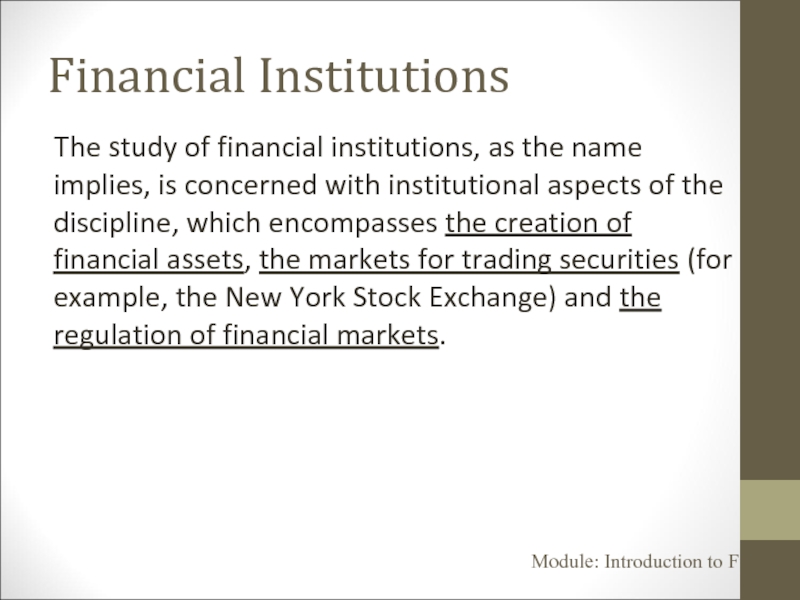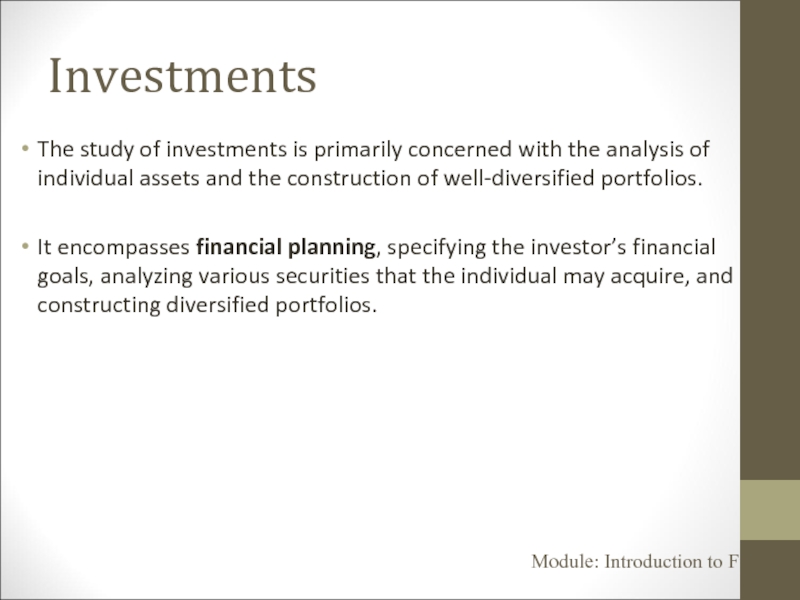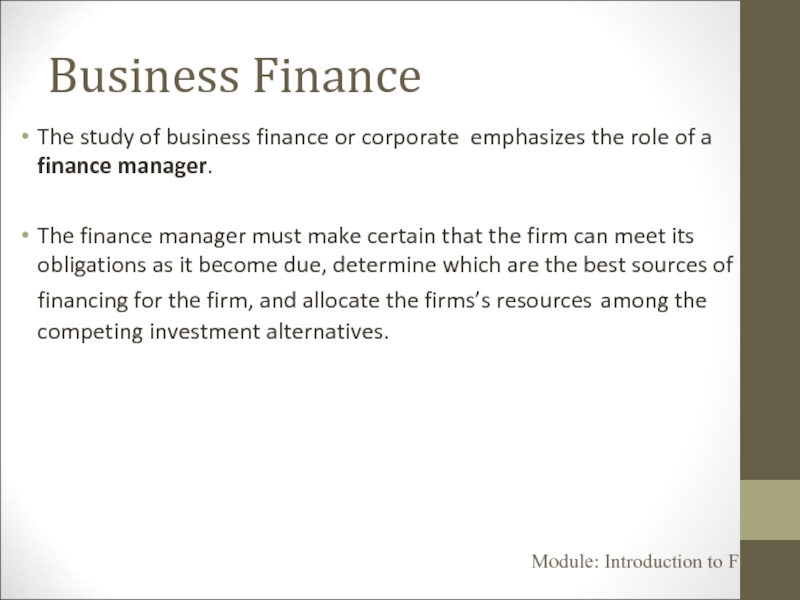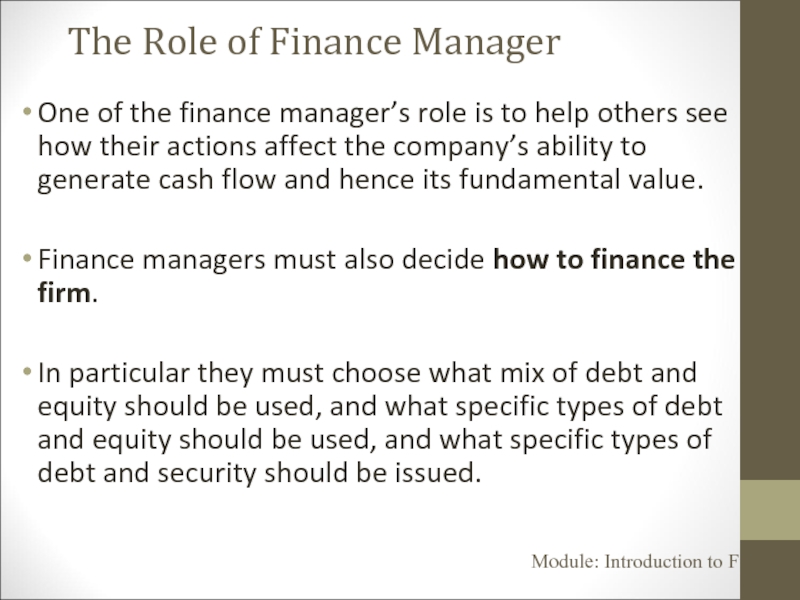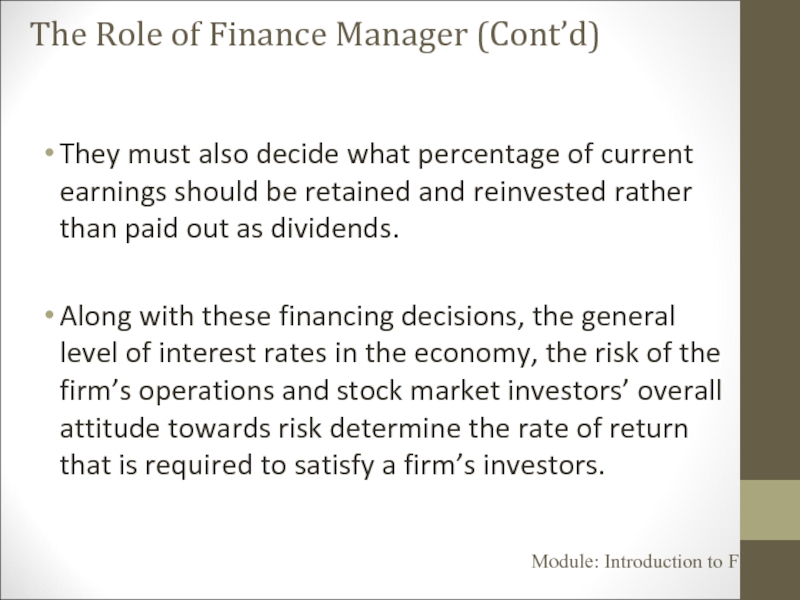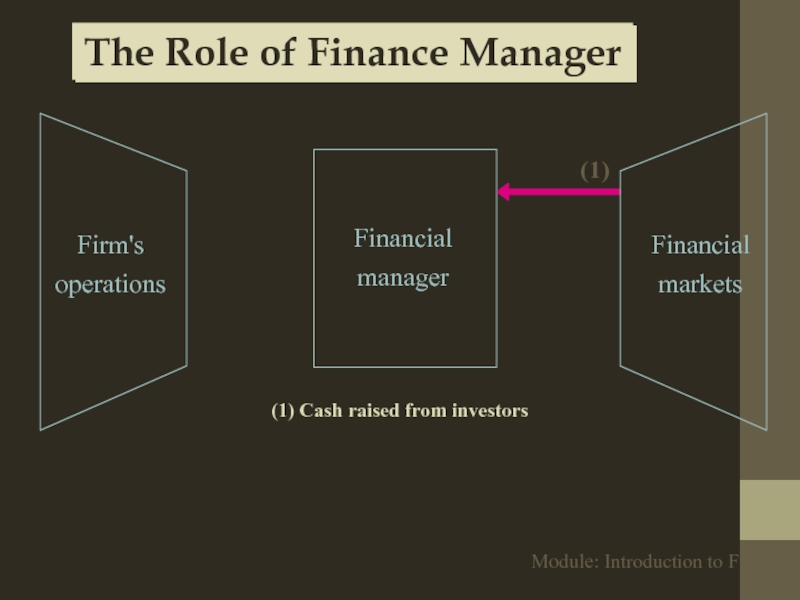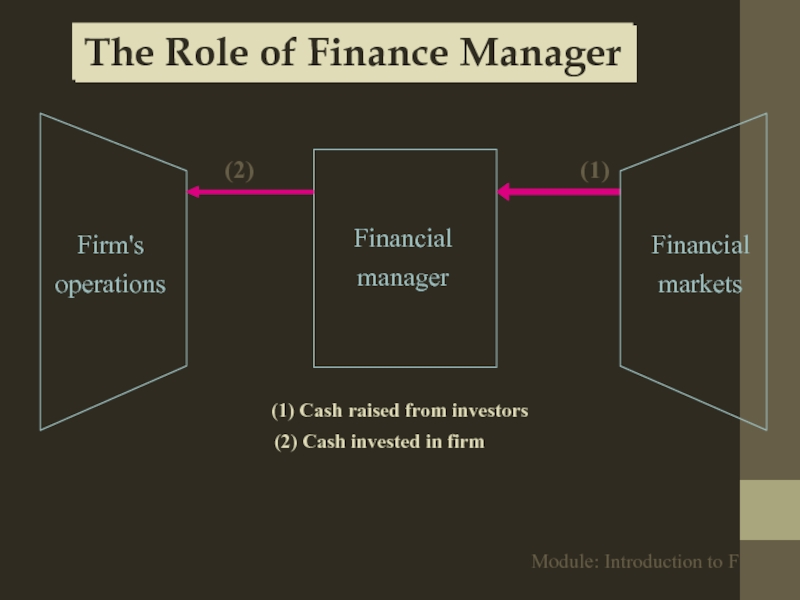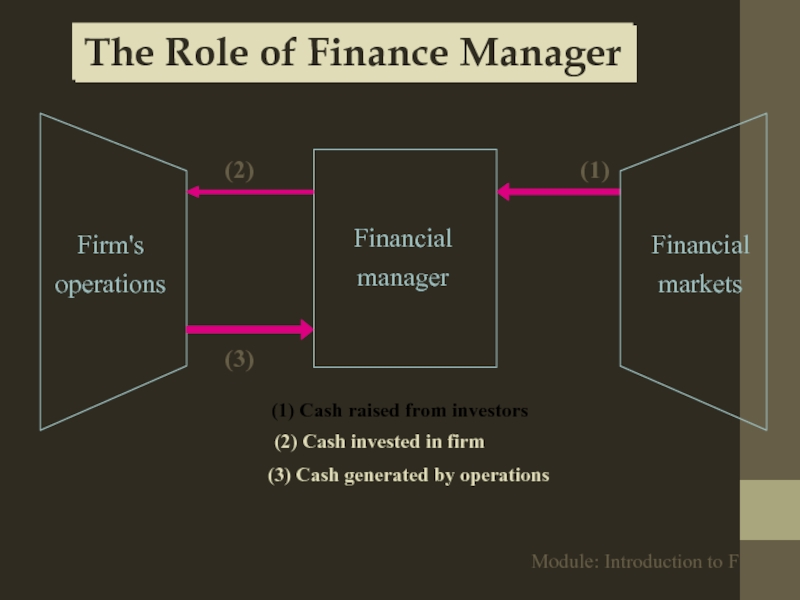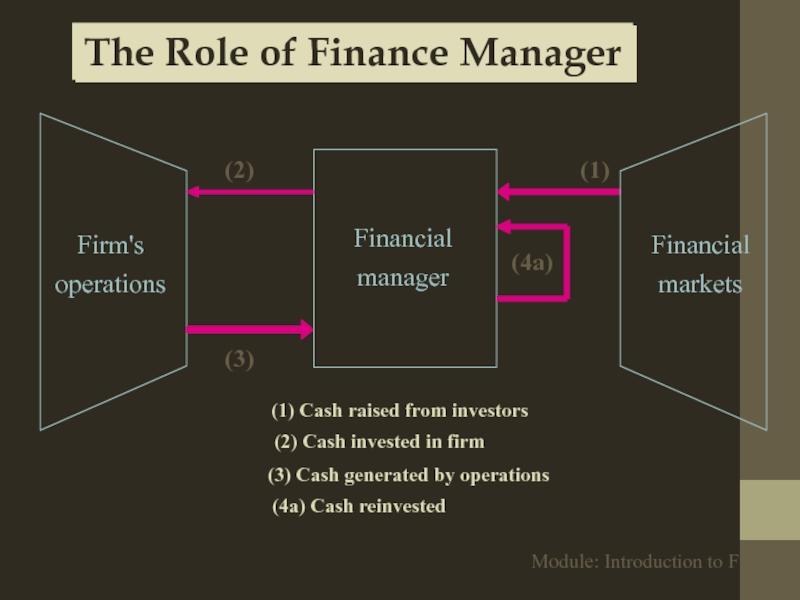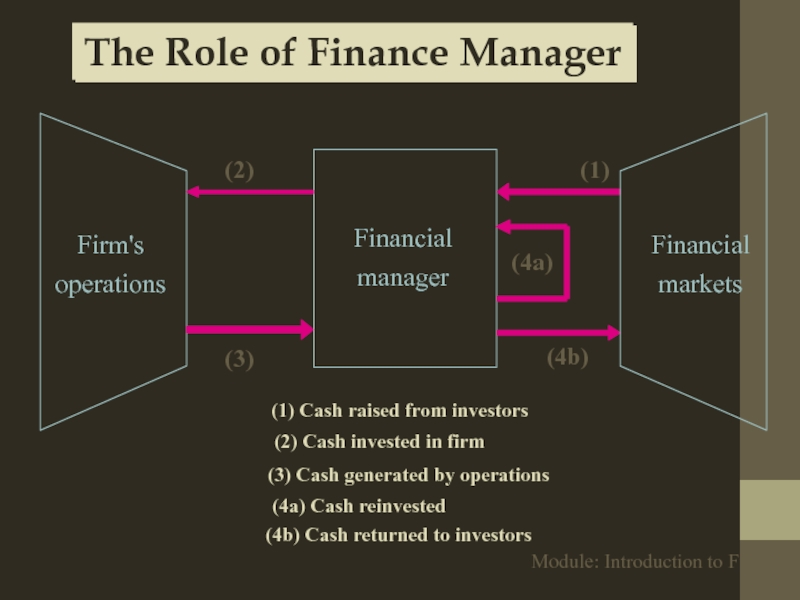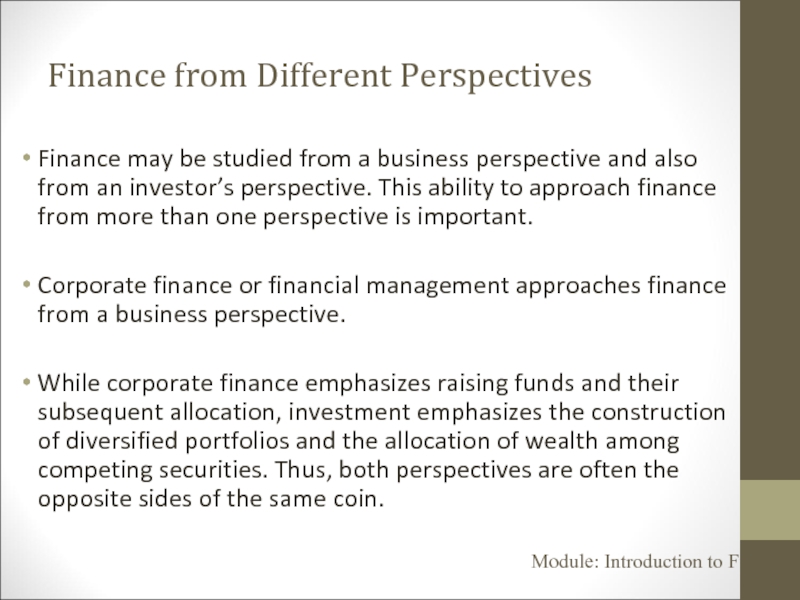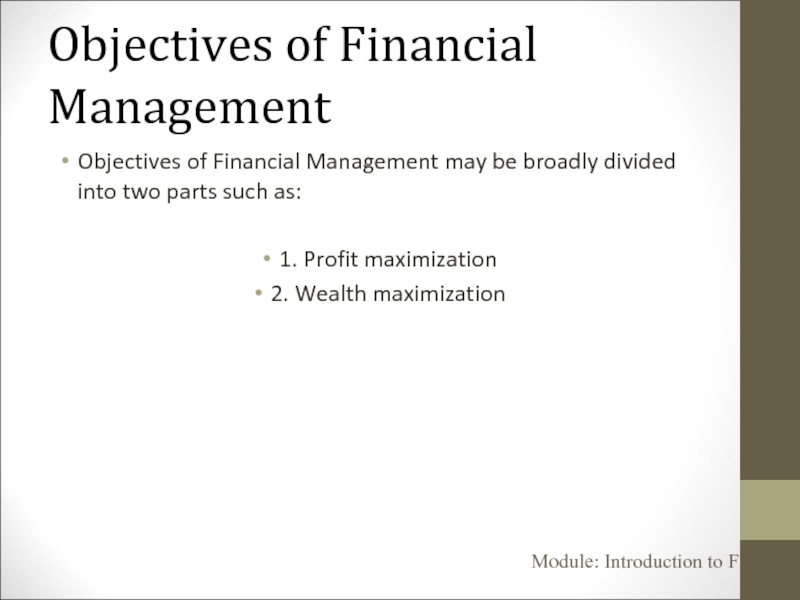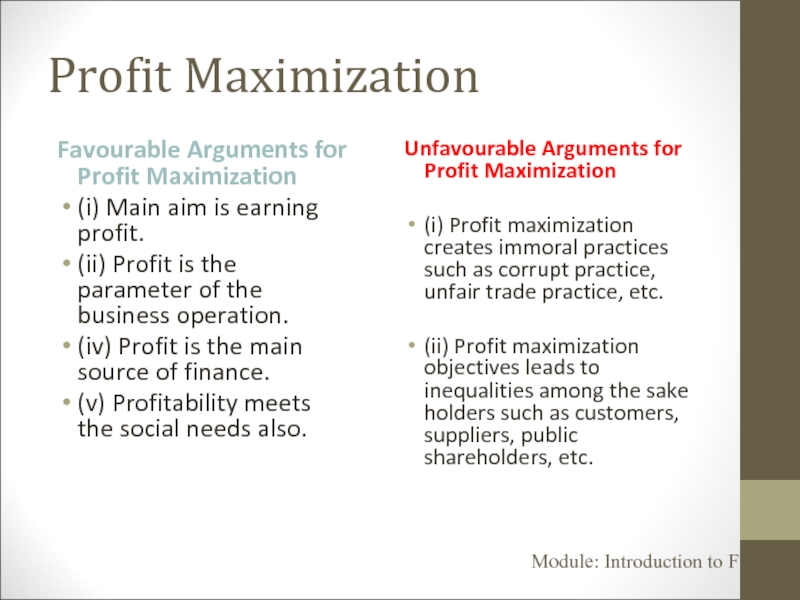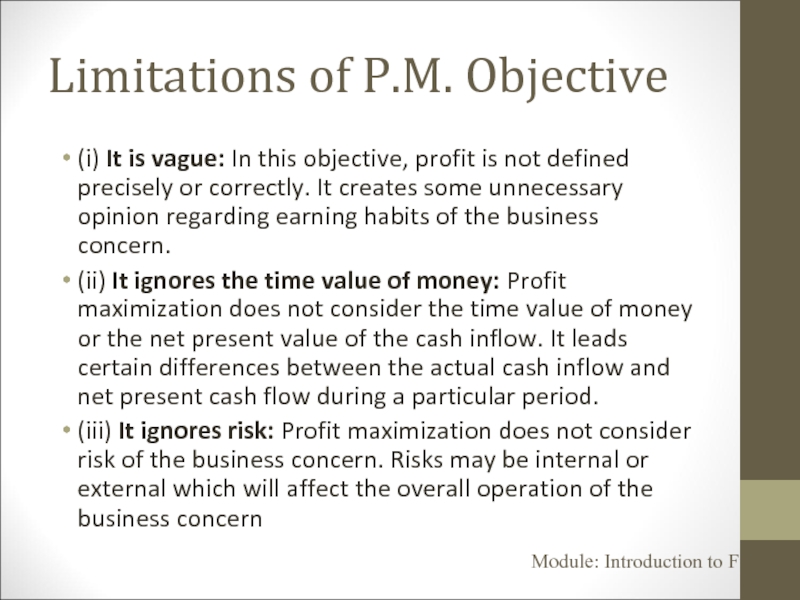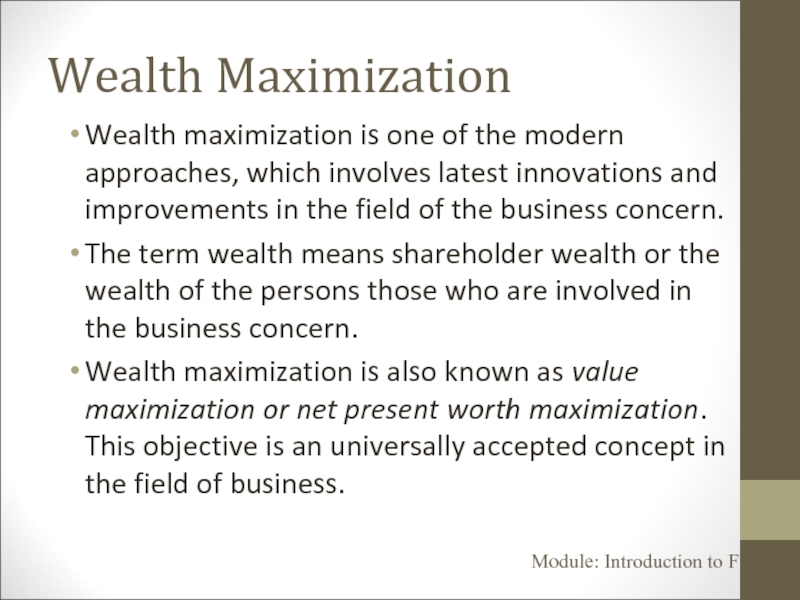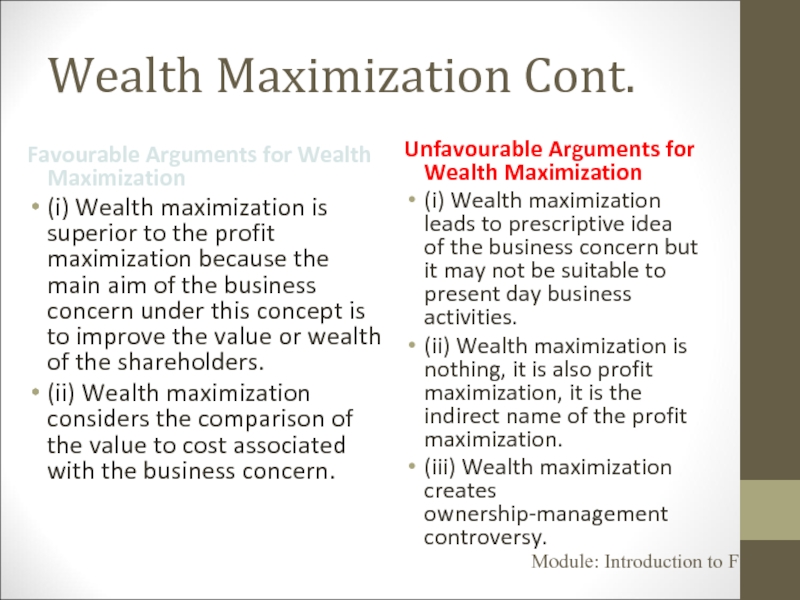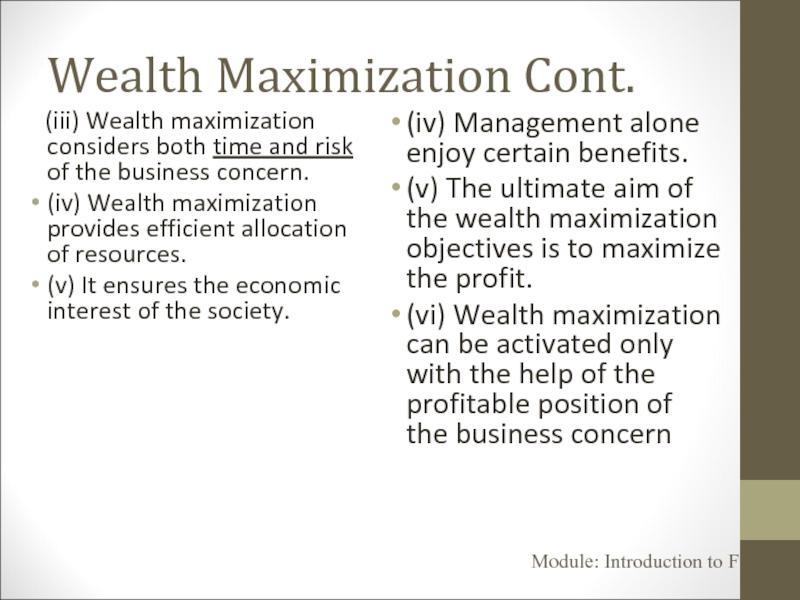Разделы презентаций
- Разное
- Английский язык
- Астрономия
- Алгебра
- Биология
- География
- Геометрия
- Детские презентации
- Информатика
- История
- Литература
- Математика
- Медицина
- Менеджмент
- Музыка
- МХК
- Немецкий язык
- ОБЖ
- Обществознание
- Окружающий мир
- Педагогика
- Русский язык
- Технология
- Физика
- Философия
- Химия
- Шаблоны, картинки для презентаций
- Экология
- Экономика
- Юриспруденция
Lecture 1 INTRODUCTION TO FINANCE
Содержание
- 1. Lecture 1 INTRODUCTION TO FINANCE
- 2. What is Finance?
- 3. Definition of FinanceAccording to Oxford dictionary, the
- 4. What Is Finance?Finance is the study of
- 5. What is Finance?Finance as a discipline is generally divided into three areas:Financial InstitutionsInvestments andBusiness Finance
- 6. What is Financial Management?Financial Management studies money
- 7. Financial Management“Financial Management is concerned with the
- 8. The
- 9. Risk and Return in FinanceRisk and return
- 10. The Role of Interest RatesAllocate scarce credit Short-term / Money markets Long-term / Capital markets
- 11. Structure of YieldsYield curve Generally, long-term debt implies higher rates (positively sloped yield curve).
- 12. Time and YieldsPositively sloped yield curve
- 13. Time and YieldsNegatively sloped yield curve
- 14. Determinants of Interest RatesPreference for shorter termMarketabilityRiskExpectations of future rates
- 15. ValuationAssets are acquired in the present, but
- 16. Financial Institutions The study of financial
- 17. InvestmentsThe study of investments is primarily concerned
- 18. Business FinanceThe study of business finance or
- 19. The Role of Finance ManagerOne of the
- 20. The Role of Finance Manager (Cont’d)They must
- 21. FinancialmanagerFirm'soperationsFinancialmarkets(1) Cash raised from investors(1)The Role of Finance Manager
- 22. FinancialmanagerFirm'soperationsFinancialmarkets(1) Cash raised from investors(2) Cash invested in firm(1)(2)The Role of Finance Manager
- 23. FinancialmanagerFirm'soperationsFinancialmarkets(1) Cash raised from investors(2) Cash invested
- 24. FinancialmanagerFirm'soperationsFinancialmarkets(1) Cash raised from investors(2) Cash invested
- 25. FinancialmanagerFirm'soperationsFinancialmarkets(1) Cash raised from investors(2) Cash invested
- 26. Finance from Different PerspectivesFinance may be studied
- 27. Objectives of Financial ManagementObjectives of Financial Management
- 28. Profit MaximizationFavourable Arguments for Profit Maximization(i) Main
- 29. Limitations of P.M. Objective(i) It is vague:
- 30. Wealth MaximizationWealth maximization is one of the
- 31. Wealth Maximization Cont.Favourable Arguments for Wealth Maximization(i)
- 32. Wealth Maximization Cont. (iii) Wealth maximization
- 33. Скачать презентанцию
Слайды и текст этой презентации
Слайд 3Definition of Finance
According to Oxford dictionary, the word ‘finance’ connotes
‘management of money’.
“the Science on study of the management of funds and the management of fund as the system that includes the circulation of money, the granting of credit, the making of investments, and the provision of banking facilities.Слайд 4What Is Finance?
Finance is the study of how and under
what terms the savings (i.e. money) are allocated between lenders
and borrowers.Finance is distinct from economics in that it addresses not only how resources are allocated but also under what terms and through what channels
Financial contracts or securities occur whenever funds are transferred from issuer to buyer.
Слайд 5What is Finance?
Finance as a discipline is generally divided into
three areas:
Financial Institutions
Investments and
Business Finance
Слайд 6What is Financial Management?
Financial Management studies money and the management
of money
Like Economics, it explores allocation of resources.
Because the future
is unknown, finance studies the allocation of resources in uncertainty. The uncertain events infuse financial decisions with risk. Слайд 7Financial Management
“Financial Management is concerned with the acquisition, financing and
management of assets with some overall goal in mind”
J.C. Van HorneThe most popular and acceptable definition of financial management as given by S.C. Kuchal:
“Financial Management deals with procurement of funds and their effective utilization in the business”.
Financial management “is an area of financial decision-making, harmonizing individual motives and enterprise goals”. Weston and Brigham
Financial management “is the operational activity of a business that is responsible for obtaining and effectively utilizing the funds necessary for efficient operations
Joshep and Massie
Слайд 8 The Finance Function
Concerned
with
Institutional
aspects
Concerned
with
Financial
Planning
Finance
Investment
Decision
Business
Finance
Concerned
with the role of the
Finance
ManagerFinancial
Institutions
Слайд 9Risk and Return in Finance
Risk and return is present in
almost every decision. Assessing the returns and risks is an
integral part of financial management.The objective in the decision making process in financial management is not to avoid risk but to properly assess it and to determine whether the risk is worth bearing.
Слайд 10The Role of Interest Rates
Allocate scarce credit
Short-term / Money markets
Long-term
/ Capital markets
Слайд 11Structure of Yields
Yield curve
Generally, long-term debt implies higher rates (positively
sloped yield curve).
Слайд 14Determinants of Interest Rates
Preference for shorter term
Marketability
Risk
Expectations of future rates
Слайд 15Valuation
Assets are acquired in the present, but their returns accrue
in the future.
No individual or firm
would purchase an asset unless there was an expected return to compensate for the risk.Since the return is earned in the uncertain future, there has to be a way to express the future in terms of the present. The process of determining what an asset is currently worth is called valuation.
Слайд 16Financial Institutions
The study of financial institutions, as the
name implies, is concerned with institutional aspects of
the discipline, which encompasses the creation of financial assets, the markets for trading securities (for example, the New York Stock Exchange) and the regulation of financial markets.Слайд 17Investments
The study of investments is primarily concerned with the analysis
of individual assets and the construction of well-diversified portfolios.
It
encompasses financial planning, specifying the investor’s financial goals, analyzing various securities that the individual may acquire, and constructing diversified portfolios. Слайд 18Business Finance
The study of business finance or corporate emphasizes the
role of a finance manager.
The finance manager must make
certain that the firm can meet its obligations as it become due, determine which are the best sources of financing for the firm, and allocate the firms’s resources among the competing investment alternatives.Слайд 19The Role of Finance Manager
One of the finance manager’s role
is to help others see how their actions affect the
company’s ability to generate cash flow and hence its fundamental value.Finance managers must also decide how to finance the firm.
In particular they must choose what mix of debt and equity should be used, and what specific types of debt and equity should be used, and what specific types of debt and security should be issued.
Слайд 20The Role of Finance Manager (Cont’d)
They must also decide what
percentage of current earnings should be retained and reinvested rather
than paid out as dividends.Along with these financing decisions, the general level of interest rates in the economy, the risk of the firm’s operations and stock market investors’ overall attitude towards risk determine the rate of return that is required to satisfy a firm’s investors.
Слайд 21Financial
manager
Firm's
operations
Financial
markets
(1) Cash raised from investors
(1)
The Role of Finance Manager
Слайд 22Financial
manager
Firm's
operations
Financial
markets
(1) Cash raised from investors
(2) Cash invested in firm
(1)
(2)
The Role
of Finance Manager
Слайд 23Financial
manager
Firm's
operations
Financial
markets
(1) Cash raised from investors
(2) Cash invested in firm
(3) Cash
generated by operations
(1)
(2)
(3)
The Role of Finance Manager
Слайд 24Financial
manager
Firm's
operations
Financial
markets
(1) Cash raised from investors
(2) Cash invested in firm
(3) Cash
generated by operations
(4a) Cash reinvested
(1)
(2)
(3)
(4a)
The Role of Finance Manager
Слайд 25Financial
manager
Firm's
operations
Financial
markets
(1) Cash raised from investors
(2) Cash invested in firm
(3) Cash
generated by operations
(4a) Cash reinvested
(4b) Cash returned to investors
(1)
(2)
(3)
(4a)
(4b)
The Role
of Finance ManagerСлайд 26Finance from Different Perspectives
Finance may be studied from a business
perspective and also from an investor’s
perspective. This ability to approach finance from more than one perspective is important.Corporate finance or financial management approaches finance from a business perspective.
While corporate finance emphasizes raising funds and their subsequent allocation, investment emphasizes the construction of diversified portfolios and the allocation of wealth among competing securities. Thus, both perspectives are often the opposite sides of the same coin.
Слайд 27Objectives of Financial Management
Objectives of Financial Management may be broadly
divided into two parts such as:
1. Profit maximization
2. Wealth maximization
Слайд 28Profit Maximization
Favourable Arguments for Profit Maximization
(i) Main aim is earning
profit.
(ii) Profit is the parameter of the business operation.
(iv) Profit
is the main source of finance.(v) Profitability meets the social needs also.
Unfavourable Arguments for Profit Maximization
(i) Profit maximization creates immoral practices such as corrupt practice, unfair trade practice, etc.
(ii) Profit maximization objectives leads to inequalities among the sake holders such as customers, suppliers, public shareholders, etc.
Слайд 29Limitations of P.M. Objective
(i) It is vague: In this objective,
profit is not defined precisely or correctly. It creates some
unnecessary opinion regarding earning habits of the business concern.(ii) It ignores the time value of money: Profit maximization does not consider the time value of money or the net present value of the cash inflow. It leads certain differences between the actual cash inflow and net present cash flow during a particular period.
(iii) It ignores risk: Profit maximization does not consider risk of the business concern. Risks may be internal or external which will affect the overall operation of the business concern
Слайд 30Wealth Maximization
Wealth maximization is one of the modern approaches, which
involves latest innovations and improvements in the field of the
business concern.The term wealth means shareholder wealth or the wealth of the persons those who are involved in the business concern.
Wealth maximization is also known as value maximization or net present worth maximization. This objective is an universally accepted concept in the field of business.
Слайд 31Wealth Maximization Cont.
Favourable Arguments for Wealth Maximization
(i) Wealth maximization is
superior to the profit maximization because the main aim of
the business concern under this concept is to improve the value or wealth of the shareholders.(ii) Wealth maximization considers the comparison of the value to cost associated with the business concern.
Unfavourable Arguments for Wealth Maximization
(i) Wealth maximization leads to prescriptive idea of the business concern but it may not be suitable to present day business activities.
(ii) Wealth maximization is nothing, it is also profit maximization, it is the indirect name of the profit maximization.
(iii) Wealth maximization creates ownership-management controversy.
Слайд 32Wealth Maximization Cont.
(iii) Wealth maximization considers both
time and risk of the business concern.
(iv) Wealth maximization
provides efficient allocation of resources.(v) It ensures the economic interest of the society.
(iv) Management alone enjoy certain benefits.
(v) The ultimate aim of the wealth maximization objectives is to maximize the profit.
(vi) Wealth maximization can be activated only with the help of the profitable position of the business concern
